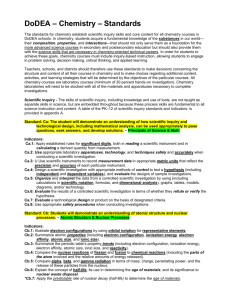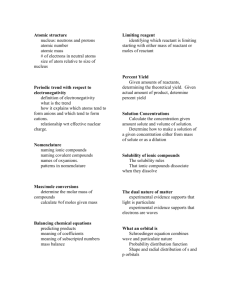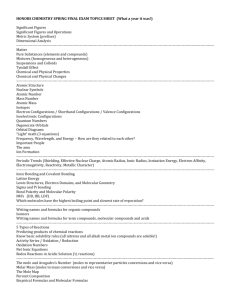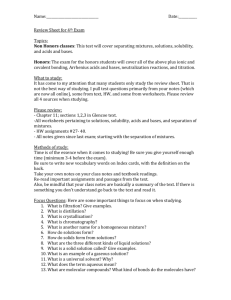Chemistry State Standards
advertisement
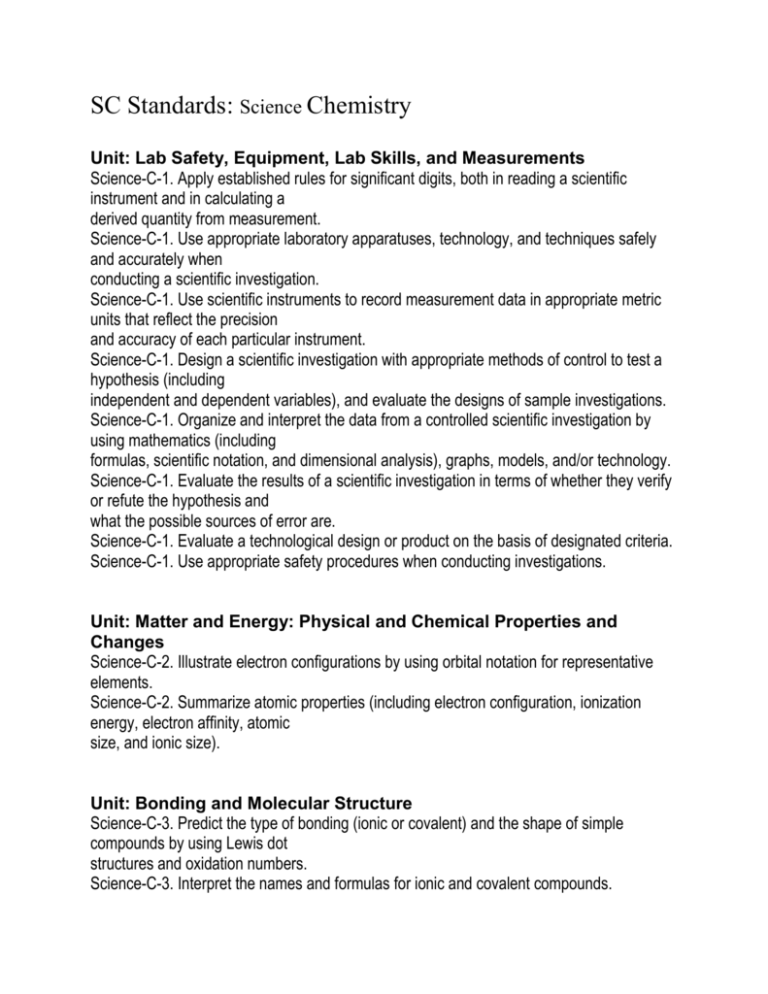
SC Standards: Science Chemistry Unit: Lab Safety, Equipment, Lab Skills, and Measurements Science-C-1. Apply established rules for significant digits, both in reading a scientific instrument and in calculating a derived quantity from measurement. Science-C-1. Use appropriate laboratory apparatuses, technology, and techniques safely and accurately when conducting a scientific investigation. Science-C-1. Use scientific instruments to record measurement data in appropriate metric units that reflect the precision and accuracy of each particular instrument. Science-C-1. Design a scientific investigation with appropriate methods of control to test a hypothesis (including independent and dependent variables), and evaluate the designs of sample investigations. Science-C-1. Organize and interpret the data from a controlled scientific investigation by using mathematics (including formulas, scientific notation, and dimensional analysis), graphs, models, and/or technology. Science-C-1. Evaluate the results of a scientific investigation in terms of whether they verify or refute the hypothesis and what the possible sources of error are. Science-C-1. Evaluate a technological design or product on the basis of designated criteria. Science-C-1. Use appropriate safety procedures when conducting investigations. Unit: Matter and Energy: Physical and Chemical Properties and Changes Science-C-2. Illustrate electron configurations by using orbital notation for representative elements. Science-C-2. Summarize atomic properties (including electron configuration, ionization energy, electron affinity, atomic size, and ionic size). Unit: Bonding and Molecular Structure Science-C-3. Predict the type of bonding (ionic or covalent) and the shape of simple compounds by using Lewis dot structures and oxidation numbers. Science-C-3. Interpret the names and formulas for ionic and covalent compounds. Science-C-3. Explain how the types of intermolecular forces present in a compound affect the physical properties of compounds (including polarity and molecular shape). Unit: Carbon Based Compounds Organic Chemistry Science-C-3. Classify organic reactions as addition, elimination, or condensation. Science-C-3. Explain the unique bonding characteristics of carbon that have resulted in the formation of a large variety of organic structures. Science-C-3. Illustrate the structural formulas and names of simple hydrocarbons (including alkanes and their isomers and benzene rings). Science-C-3. Identify the basic structure of common polymers (including proteins, nucleic acids, plastics, and starches). Science-C-3. Classify organic compounds in terms of their functional group. Science-C-3. Explain the effect of electronegativity and ionization energy on the type of bonding in a molecule. Science-C-3. Classify polymerization reactions as addition or condensation. Unit: Periodic Table, Periodic Trends Science-C-2. Summarize the periodic table's property trends (including electron configuration, ionization energy, electron affinity, atomic size, ionic size, and reactivity). Unit: Reactions (Types and Balancing) Science-C-4. Analyze and balance equations for simple synthesis, decomposition, single replacement, double replacement, and combustion reactions. Science-C-4. Predict the products of acid-base neutralization and combustion reactions. Science-C-4. Analyze the energy changes (endothermic or exothermic) associated with chemical reactions. Unit: Stoichiometry Science-C-4. Explain the role of collision frequency, the energy of collisions, and the orientation of molecules in reaction rates. Science-C-4. Apply the concept of moles to determine the number of particles of a substance in a chemical reaction, the percent composition of a representative compound, the mass proportions, and the molemass relationships. Science-C-4. Predict the percent yield, the mass of excess, and the limiting reagent in chemical reactions. Science-C-4. Explain the role of activation energy and the effects of temperature, particle size, stirring, concentration, and catalysts in reaction rates. Science-C-4. Summarize the oxidation and reduction processes (including oxidizing and reducing agents). Science-C-4. Illustrate the uses of electrochemistry (including electrolytic cells, voltaic cells, and the production of metals from ore by electrolysis). Science-C-4. Summarize the concept of chemical equilibrium and Le ChΓtelier's principle. Unit: Acids Bases Salts- Identification, Properties, and Reactions Science-C-6. Interpret solubility curves to determine saturation at different temperatures. Science-C-6. Use a variety of procedures for separating mixtures (including distillation, crystallization filtration, paper chromatography, and centrifuge). Science-C-6. Use solubility rules to write net ionic equations for precipitation reactions in aqueous solution. Science-C-6. Use the calculated molality of a solution to calculate the freezing point depression and the boiling point elevation of a solution. Science-C-6. Represent neutralization reactions and reactions between common acids and metals by using chemical equations. Science-C-6. Analyze the composition of a chemical sample by using gas chromatography. Science-C-6. Summarize the properties of salts, acids, and bases. Science-C-6. Distinguish between strong and weak common acids and bases. Science-C-6. Represent common acids and bases by their names and formulas. Science-C-6. Use the hydronium or hydroxide ion concentration to determine the pH and pOH of aqueous solutions. Science-C-6. Explain how the use of a titration can determine the concentration of acid and base solutions Unit: Gas Laws States of Matter Science-C-5. Explain the effects of the intermolecular forces on the different phases of matter. Science-C-5. Explain the behaviors of gas; the relationship among pressure, volume, and temperature; and the significance of the Kelvin (absolute temperature) scale, using the kinetic-molecular theory as a model. Science-C-5. Apply the gas laws to problems concerning changes in pressure, volume, or temperature (including Charles's law, Boyle's law, and the combined gas law). Science-C-5. Illustrate and interpret heating and cooling curves (including how boiling and melting points can be identified and how boiling points vary with changes in pressure). Science-C-5. Analyze the energy changes involved in calorimetry by using the law of conservation of energy as it applies to temperature, heat, and phase changes (including the use of the formulas q = mc?T [temperature change] and q = mLv and q = mLf [phase change] to Science-C-5. Use density to determine the mass, volume, or number of particles of a gas in a chemical reaction. Science-C-5. Apply the ideal gas law (pV = nRT) to solve problems. Science-C-5. Analyze a product for purity by following the appropriate assay procedures. Science-C-5. Analyze a chemical process to account for the weight of all reagents and solvents by following the appropriate material balance procedures. Unit: Nuclear Chemistry Science-C-2. Compare the nuclear reactions of fission and fusion to chemical reactions (including the parts of the atom involved and the relative amounts of energy released). Science-C-2. Compare alpha, beta, and gamma radiation in terms of mass, charge, penetrating power, and the release of these particles from the nucleus. Science-C-2. Explain the concept of half-life, its use in determining the age of materials, and its significance to nuclear waste disposal. Science-C-2. Apply the predictable rate of nuclear decay (half-life) to determine the age of materials. Science-C-2. Analyze a decay series chart to determine the products of successive nuclear reactions and write nuclear equations for disintegration of specified nuclides. Science-C-2. Use the equation E = mc2 to determine the amount of energy released during nuclear reactions. Unit: Solubility and Solutions Science-C-6. Summarize the process by which solutes dissolve in solvents, the dynamic equilibrium that occurs in saturated solutions, and the effects of varying pressure and temperature on solubility. Science-C-6. Compare solubility of various substances in different solvents (including polar and nonpolar solvents and organic and inorganic substances). Science-C-6. Illustrate the colligative properties of solutions (including freezing point depression and boiling point elevation and their practical uses). Science-C-6. Carry out calculations to find the concentration of solutions in terms of molarity and percent weight (mass). August
